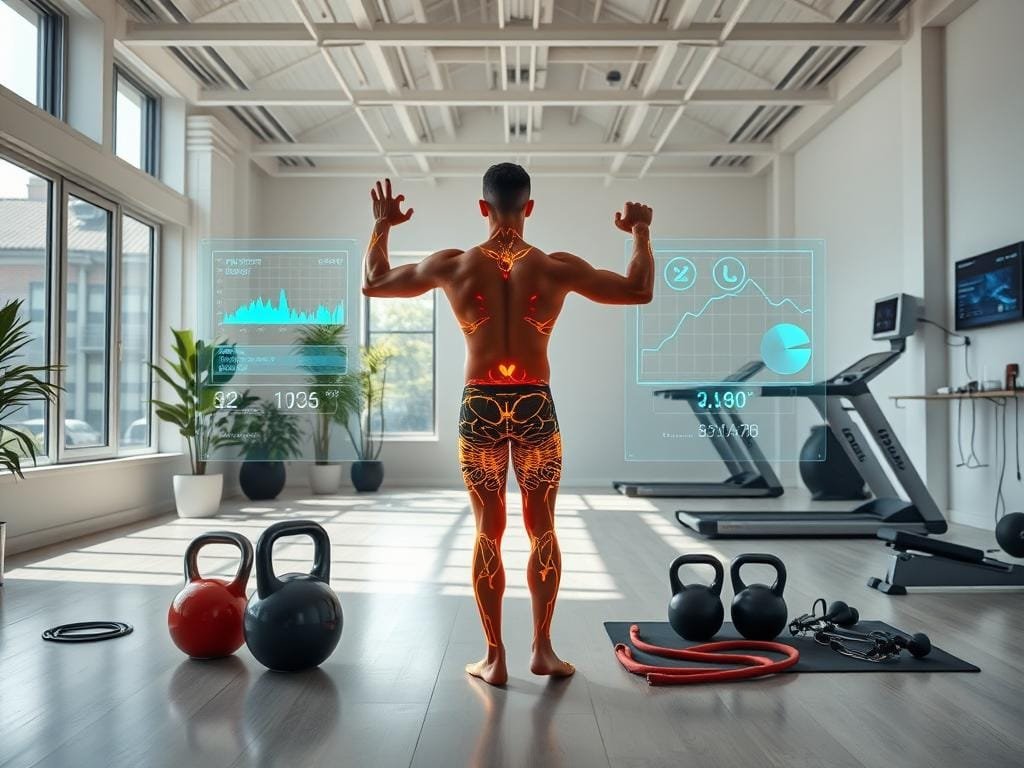Did you know simple changes can boost your well-being? Biohacking uses science to improve your body’s performance. By making smart lifestyle choices, you can increase your energy, focus, and health.
Begin by adding meditation, exercise, and healthy eating to your day. Try intermittent fasting and getting more sunlight too. For more tips, check out biohacking guides that share health optimization strategies.
Table of Contents
Key Takeaways
- Start with simple practices like meditation and regular exercise.
- Incorporate healthy nutrition and consider techniques like intermittent fasting.
- Exposure to natural light can help control your biological rhythm.
- Explore various biohacking strategies to find what works best for you.
- Utilize resources and guides to deepen your understanding of biohacking.
What Is Biohacking? Understanding the Science of Self-Improvement
Biohacking lets you take control of your health and well-being. It mixes science with self-discovery. This way, you can make health choices based on data.
The Definition and Philosophy of Biohacking
Biohacking uses science and tech to boost health and performance. It’s about self-improvement and health optimization. By understanding your biology, you can tailor your health plan.
For example, you might try different diets or sleep routines. This self-experimentation is key to biohacking. It helps you find what’s best for your body.
| Key Principles | Description |
|---|---|
| Self-Experimentation | Testing different approaches to health and wellness to find what works best for you. |
| Data-Driven Decisions | Using data from experiments and tracking to inform health and wellness choices. |
| Personalization | Tailoring health strategies to your unique biology and needs. |
How Biohacking Differs from Traditional Health Approaches
Biohacking focuses on optimizing your entire system. It looks at how different parts of your body work together. For instance, you might study how food affects your energy or how supplements help your brain.
For more on supplements, check out The Truth About Effective Natural Supplements.
Biohacking is a holistic, proactive way to manage your health. It makes you an active part of your health journey, not just a passive receiver.
The Science Behind Biohacking: How Small Changes Create Big Results
Learning about biohacking can help you control your health. It’s about using science and trying things out to improve your well-being. Small, smart changes can lead to big health improvements.

Understanding Your Body’s Systems and Feedback Loops
Your body is complex, with feedback loops that keep it balanced. Biohacking is about understanding these systems and making choices based on data. For example, tracking your heart rate variability (HRV) can show how stressed you are and how well you recover.
Using technology and trying new things can help you find what’s best for your body. This might mean trying different foods, sleep habits, or workouts. The important thing is to be methodical and patient, letting data lead your way.
The Role of Epigenetics in Personal Health Optimization
Epigenetics is key in biohacking, showing how lifestyle affects your genes. Learning about epigenetics helps you make healthy choices. For instance, exercise and diet can change your genes, possibly lowering disease risk.
By focusing on personal health optimization through epigenetics, you can actively improve your health. This means paying attention to your environment, stress, and other factors that affect your genes.
To start, try simple things like meditation, changing your diet, or supplements. See how these changes affect you and adjust as needed. The aim is to create a biohacking plan that supports your health goals.
Biohacking for Beginners: Simple Strategies to Start Your Journey
Starting with biohacking can feel overwhelming. But, setting clear goals is key. Biohacking is about making small changes to better your health and happiness.
Setting Realistic Goals for Your Biohacking Journey
Setting realistic goals is vital for success in biohacking. First, decide what you want to achieve. This could be better sleep, more energy, or clearer thinking. Make sure your goals are specific, measurable, and attainable.
For example, instead of “I want to be healthier,” say “I will eat only one serving of sugar per day.” This keeps you focused and motivated. Learn more about setting health goals in our article on starting a healthy lifestyle from scratch.
Creating Your Personal Biohacking Framework
After setting your goals, create a personal biohacking framework. Choose strategies that match your goals. Start with simple things like intermittent fasting, meditation, or better sleep habits.
Try different methods to find what works for you. Remember, biohacking takes time and patience. What works for one person might not work for another.
Tracking Your Progress: Tools and Methods
Tracking your progress is key to seeing how well your strategies work. Use tools like wearable devices, apps, or journals. Popular tools include heart rate trackers, sleep monitors, and nutrition apps.
Looking at your data regularly helps you spot patterns. It also keeps you motivated by showing how far you’ve come.
Nutrition Hacking: Optimize Your Diet for Enhanced Performance
Nutrition hacking means making smart choices to boost your body’s performance and health. By learning about the best nutrition, you can increase your energy, brain power, and health.
Understanding Macronutrients and Micronutrients
Macronutrients like carbs, proteins, and fats give you energy and help your body grow. Knowing how much you need is key to a good diet. Micronutrients, like vitamins and minerals, are important for energy, fighting off sickness, and staying healthy.
Eating a balanced diet with lots of whole foods is best. Include fruits, veggies, lean proteins, and whole grains. These foods give you the nutrients your body needs to work well.

Intermittent Fasting and Time-Restricted Eating
Intermittent fasting (IF) and time-restricted eating (TRE) are popular for improving health. IF means fasting or eating less at times, then eating freely. TRE means eating only during a certain time each day. Both can make your body better at using insulin, help with weight loss, and support overall health.
Start with a 12-hour eating window if you’re new to this. Listen to your body and adjust your fasting times as needed.
Supplements for Beginners: What’s Worth Your Investment
Even with a good diet, supplements can fill in the gaps. For newbies, choose supplements that boost health and performance. Always talk to a healthcare expert before starting any supplements.
Good supplements for beginners include multivitamins, omega-3s, and probiotics. They help with immune function, heart health, and digestion.
Sleep Optimization: Enhance Your Recovery and Cognitive Function
Quality sleep is key to good health and sharp thinking. It’s important to know how to improve your sleep.
The Science of Sleep Cycles and Brain Health
Sleep is not just one state but a mix of stages, like REM and non-REM sleep. These stages help our brains, improving memory, emotions, and thinking skills.
Sleep Cycles and Their Impact:
| Sleep Stage | Characteristics | Impact on Health |
|---|---|---|
| Non-REM Sleep | Includes three stages, from light to deep sleep | Helps with physical recovery and strengthens the immune system |
| REM Sleep | Known for rapid eye movements and vivid dreams | Important for memory, learning, and emotional balance |
Creating the Optimal Sleep Environment
Your sleep space greatly affects how well you sleep. Things like light, temperature, and noise matter a lot.
To make your sleep space better, try these:
- Keep your bedroom cool, dark, and quiet.
- Choose a comfy mattress and pillows.
- Stay away from screens before bed.
Sleep-Tracking Technology for Beginners
For sleep tracking newbies, tech is a great help. Wearables and apps track your sleep, showing how to improve it.
For deeper sleep hacking, like using AI, check out our sleep biohacking guide.

Movement and Exercise: Biohacking Your Fitness Routine
You can make your fitness routine better by using biohacking. Biohacking means using data and tech to improve your health and fitness. By knowing how your body reacts to different exercises and recovery methods, you can make your routine more effective.

Minimum Effective Dose: Efficient Exercise Strategies
The Minimum Effective Dose (MED) is key in biohacking your fitness. MED is the least amount of exercise needed to reach your fitness goals. This way, you avoid overtraining and reduce injury risks. It’s about finding the most effective exercises and adding them to your routine.
High-intensity interval training (HIIT) is a great example. It boosts heart health and muscle strength. Adding HIIT to your routine can help you get fit faster.
Zone2 Training and Heart Rate Variability
Zone2 training is another important part of biohacking your fitness. It means working out at a moderate level, where you can talk but are working hard. It’s good for your heart and endurance.
Heart Rate Variability (HRV) is also key. HRV is the change in time between heartbeats. A higher HRV means better heart health and stress resilience. Monitoring HRV helps you understand how your body reacts to exercise and rest.
To learn more about these strategies, visit https://www.biohackers.world/blog/fitness-and-biohacking. There, you can find the latest biohacking tips for fitness.
Recovery Techniques for Optimal Performance
Recovery is vital for any fitness plan. Using good recovery methods helps you perform better and lowers injury risk. Techniques like foam rolling, stretching, and contrast showers are effective.
- Foam rolling eases muscle soreness and boosts circulation.
- Stretching improves flexibility and reduces muscle tension.
- Contrast showers alternate hot and cold water to improve circulation and reduce swelling.
By adding these recovery methods to your routine, you can enhance your performance and reach your fitness goals more efficiently.
Cognitive Enhancement: Strategies for Mental Performance
Starting your biohacking journey? Cognitive enhancement strategies can boost your mental skills. These methods aim to improve memory, creativity, and problem-solving.
Nootropics and Brain-Boosting Compounds
Nootropics are substances that boost brain function. They help with memory, creativity, and motivation. Modafinil, Bacopa Monnieri, and Rhodiola Rosea are some well-known nootropics. Research shows they can have cognitive benefits, as seen on the National Center for Biotechnology Information website.
It’s key to know how nootropics work and their side effects. Being informed helps you use them effectively.
| Nootropic | Primary Benefit | Potential Side Effects |
|---|---|---|
| Modafinil | Improved wakefulness and alertness | Headache, nausea, anxiety |
| Bacopa Monnieri | Enhanced memory and cognitive processing | Gastrointestinal upset |
| Rhodiola Rosea | Reduced stress, improved mental performance | Dizziness, dry mouth |
Meditation and Mindfulness Practices
Meditation and mindfulness are great for your brain. They improve attention, memory, and emotional control. Practices like mindful breathing and body scan meditation lower stress and boost flexibility.
- Mindfulness meditation
- Focused attention meditation
- Open monitoring meditation
Brain Training and Neuroplasticity Exercises
Brain training and neuroplasticity exercises challenge your brain. They improve cognitive skills like memory and attention. These exercises can enhance your brain’s abilities and build cognitive reserve.
Examples of brain training exercises include:
- Memory games
- Attention and focus training
- Processing speed exercises
Environmental Biohacking: Optimizing Your Surroundings
Environmental biohacking means making smart changes to your space to boost health and work performance. By tweaking your environment, you can greatly improve your well-being and how well you do things.
Light Exposure and Circadian Rhythm Optimization
Light is key to keeping your body’s internal clock in sync. This clock controls when you feel awake and when you sleep. To get the most from light:
- Start your day with bright light therapy to set your clock right.
- Try to avoid screens with blue light in the evening to sleep better.
- Look into light-filtering glasses or apps to block blue light.
Controlling light helps you sleep better and stay healthy. For more tips on biohacking, check out Medical News Today for lots of advice.
Air Quality, Water Filtration, and EMF Considerations
The air and water you use can really affect your health. Here’s how to improve them:
- Get an air purifier to clean your indoor air of pollutants and allergens.
- Install a water filter to make sure your water is clean and free of chemicals.
- Use EMF meters to check how much electromagnetic fields you’re exposed to.
By doing these things, you can lower your risk of harm from the environment. This helps you stay healthier and feel better overall.
To really boost your biohacking, check your home and work for other things that might harm you. Think about noise or mold. A cleaner environment helps your body work better and makes you more resilient to stress.
Finding Your Biohacking Community in the United States
Starting your biohacking journey can be exciting. Connecting with others who share your interests is key. The biohacking community offers many resources, from online forums to local meetups, all aimed at helping you achieve optimal health.
Online Forums and Social Media Groups
Online platforms are great for meeting others interested in biohacking. Sites like Reddit have communities where you can ask questions and share experiences. Facebook groups and forums also offer spaces for discussion and networking.
Here are some tips for getting the most out of online forums and social media groups:
- Be active and engage with others’ posts.
- Share your own experiences to help others.
- Follow community guidelines to maintain a positive environment.
Local Biohacking Meetups and Wellness Centers
In-person connections are valuable too. Local meetups and wellness centers host events on biohacking and related topics. These events offer chances to network, learn from experts, and try new techniques.
Some popular local events include:
| Event Type | Description | Benefits |
|---|---|---|
| Workshops | Hands-on sessions on specific biohacking techniques. | Practical skills, networking. |
| Seminars | Educational sessions on various biohacking topics. | Knowledge expansion, expert insights. |
| Meetups | Informal gatherings for biohackers to share experiences. | Community building, support. |
Working with Health Optimization Practitioners
Working with health optimization practitioners can be very helpful. They provide personalized advice, help set goals, and track your progress. They might be nutritionists, fitness coaches, or health consultants with biohacking expertise.
When choosing a practitioner, look for:
- Relevant certifications and experience.
- A personalized approach to your health goals.
- Positive reviews and testimonials from previous clients.
By joining the biohacking community, whether online or in-person, and working with professionals, you can greatly improve your health journey.
Common Biohacking Mistakes and How to Avoid Them
Starting your biohacking journey? It’s key to know the common mistakes that can slow you down. Biohacking, done right, can boost your health and happiness. But, some wrong steps can cause setbacks, bad results, or even harm.
Doing Too Much Too Soon
Trying to change too much at once is a big mistake in biohacking. It can exhaust you, both in body and mind. Begin with small, easy changes that you can keep up with. For example, start with a 12-hour fast and then slowly increase it, instead of diving into a 24-hour fast right away.
Ignoring Bio-Individuality
Biohacking doesn’t fit everyone the same way. What works for one might not work for another because of genetic, lifestyle, and health differences. It’s vital to listen to your body and adjust your plans based on how you feel. Keeping a detailed log of your experiments and results can help you find what works best for you.
Expert Insights: Lessons from Leading Biohackers
Learning from seasoned biohackers can teach you a lot and help you avoid common errors. They stress the need for patience, persistence, and a personalized approach. For instance, Dave Asprey, a famous biohacker, suggests a slow and informed way to biohack. He believes it’s about making lasting lifestyle changes, not quick fixes.
By knowing these common mistakes and taking a careful, informed path in biohacking, you can greatly increase your success. This way, you’ll reach your health optimization goals.
Conclusion: Your Personalized Path to Optimal Health
Biohacking is a way to get to your best health. It’s all about making plans that fit just right for you. This lets you reach your health goals and see big improvements.
We’ve looked at many biohacking methods in this article. These include better eating, sleeping, thinking, and living in a healthy environment. Using these tips, you can manage your health and make choices that help you reach your goals.
Starting your biohacking journey means finding what’s best for you. With the knowledge and tools we’ve shared, you can make a plan that really works. This plan will help you feel better and live a more energetic life.
By diving into biohacking, you’re on your way to the best health ever. Your journey to a healthier life begins today.

